open hood GMC SIERRA CLASSIC 2007 Owners Manual
[x] Cancel search | Manufacturer: GMC, Model Year: 2007, Model line: SIERRA CLASSIC, Model: GMC SIERRA CLASSIC 2007Pages: 674, PDF Size: 3.5 MB
Page 139 of 674
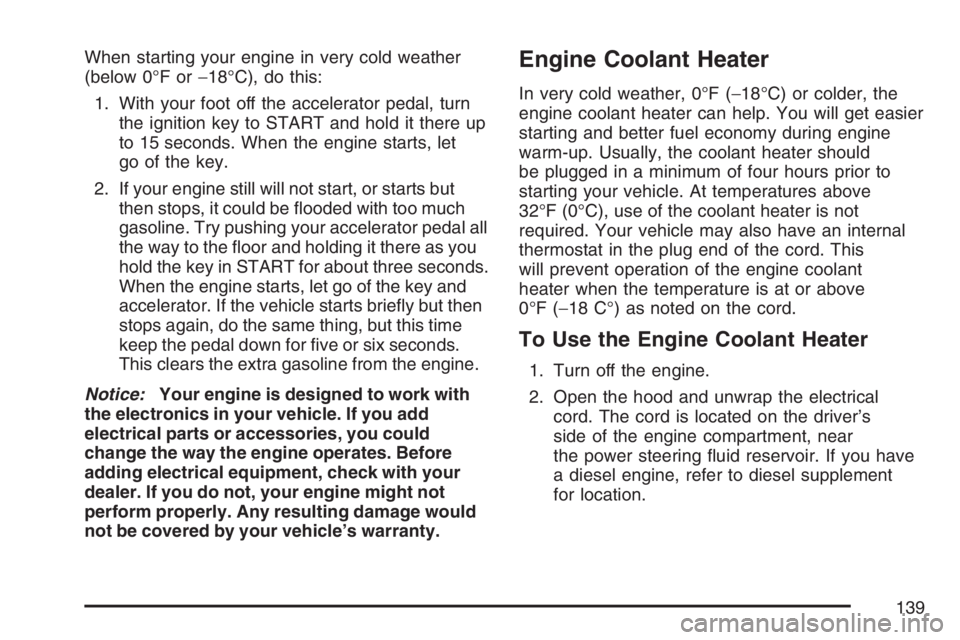
When starting your engine in very cold weather
(below 0°F or−18°C), do this:
1. With your foot off the accelerator pedal, turn
the ignition key to START and hold it there up
to 15 seconds. When the engine starts, let
go of the key.
2. If your engine still will not start, or starts but
then stops, it could be �ooded with too much
gasoline. Try pushing your accelerator pedal all
the way to the �oor and holding it there as you
hold the key in START for about three seconds.
When the engine starts, let go of the key and
accelerator. If the vehicle starts brie�y but then
stops again, do the same thing, but this time
keep the pedal down for �ve or six seconds.
This clears the extra gasoline from the engine.
Notice:Your engine is designed to work with
the electronics in your vehicle. If you add
electrical parts or accessories, you could
change the way the engine operates. Before
adding electrical equipment, check with your
dealer. If you do not, your engine might not
perform properly. Any resulting damage would
not be covered by your vehicle’s warranty.Engine Coolant Heater
In very cold weather, 0°F (−18°C) or colder, the
engine coolant heater can help. You will get easier
starting and better fuel economy during engine
warm-up. Usually, the coolant heater should
be plugged in a minimum of four hours prior to
starting your vehicle. At temperatures above
32°F (0°C), use of the coolant heater is not
required. Your vehicle may also have an internal
thermostat in the plug end of the cord. This
will prevent operation of the engine coolant
heater when the temperature is at or above
0°F (−18 C°) as noted on the cord.
To Use the Engine Coolant Heater
1. Turn off the engine.
2. Open the hood and unwrap the electrical
cord. The cord is located on the driver’s
side of the engine compartment, near
the power steering �uid reservoir. If you have
a diesel engine, refer to diesel supplement
for location.
139
Page 471 of 674

If your vehicle has the 6.0L V8 engine
(VIN Code N), use premium unleaded gasoline
with a posted octane rating of 91 or higher.
You may also use regular unleaded gasoline rated
at 87 octane or higher, but your vehicle’s
acceleration may be slightly reduced, and you
may notice a slight audible knocking noise,
commonly referred to as spark knock. If the octane
is less than 87, you may notice a heavy knocking
noise when you drive. If this occurs, use a
gasoline rated at 87 octane or higher as soon as
possible. Otherwise, you might damage your
engine. If you are using gasoline rated at
87 octane or higher and you hear heavy knocking,
your engine needs service.
Gasoline Speci�cations
At a minimum, gasoline should meet ASTM
speci�cation D 4814 in the United States or
CAN/CGSB-3.5 in Canada. Some gasolines may
contain an octane-enhancing additive called
methylcyclopentadienyl manganese tricarbonyl
(MMT). General Motors recommends against the
use of gasolines containing MMT. SeeAdditives
on page 472for additional information.
California Fuel
If your vehicle is certi�ed to meet California
Emissions Standards, it is designed to operate on
fuels that meet California speci�cations. See the
underhood emission control label. If this fuel is not
available in states adopting California emissions
standards, your vehicle will operate satisfactorily on
fuels meeting federal speci�cations, but emission
control system performance may be affected. The
malfunction indicator lamp may turn on and your
vehicle may fail a smog-check test. SeeMalfunction
Indicator Lamp on page 258. If this occurs, return to
your authorized GM dealer for diagnosis. If it is
determined that the condition is caused by the type
of fuel used, repairs may not be covered by your
warranty.
471
Page 479 of 674
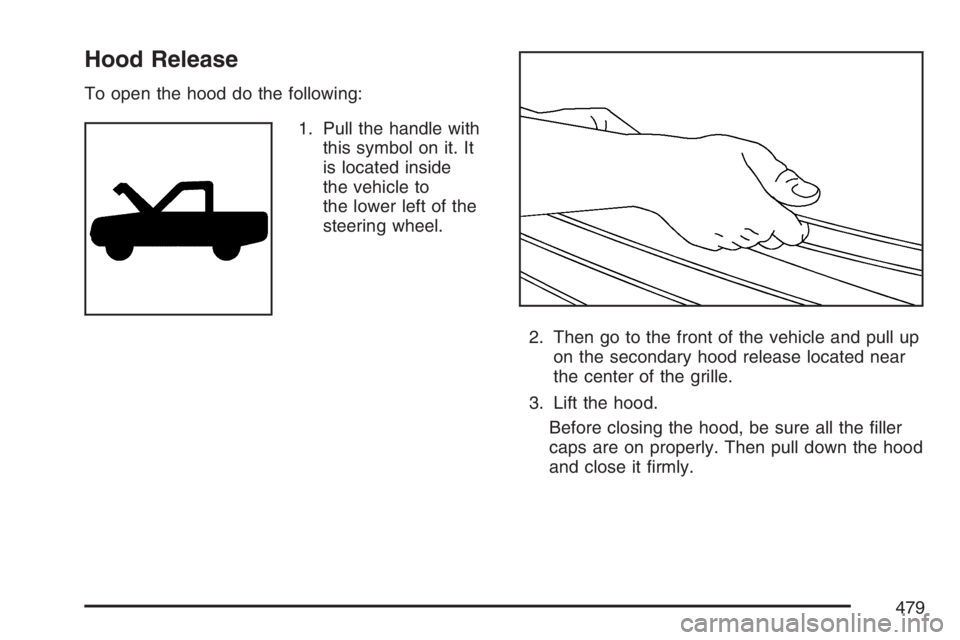
Hood Release
To open the hood do the following:
1. Pull the handle with
this symbol on it. It
is located inside
the vehicle to
the lower left of the
steering wheel.
2. Then go to the front of the vehicle and pull up
on the secondary hood release located near
the center of the grille.
3. Lift the hood.
Before closing the hood, be sure all the �ller
caps are on properly. Then pull down the hood
and close it �rmly.
479
Page 480 of 674
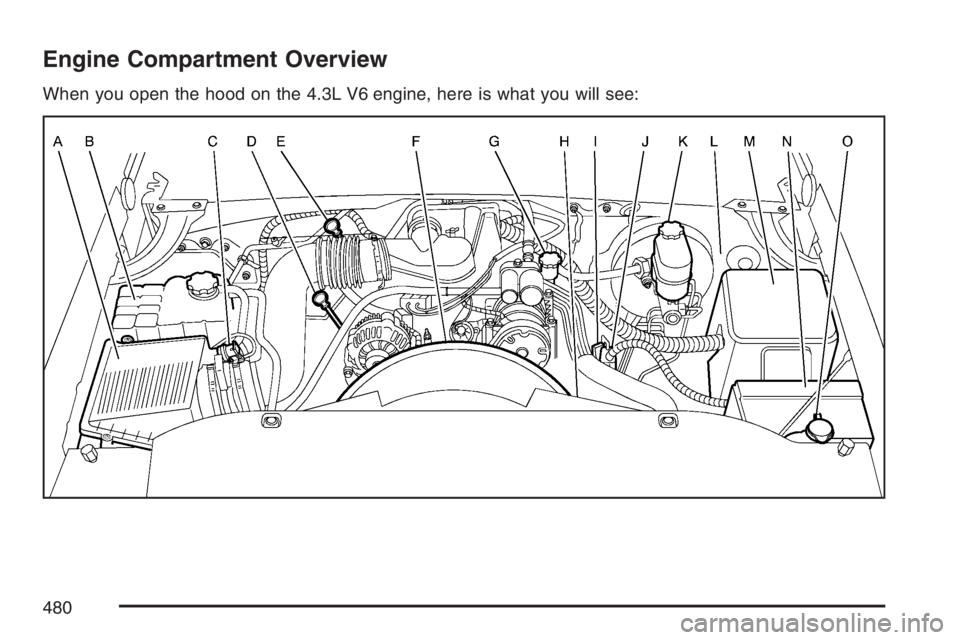
Engine Compartment Overview
When you open the hood on the 4.3L V6 engine, here is what you will see:
480
Page 482 of 674
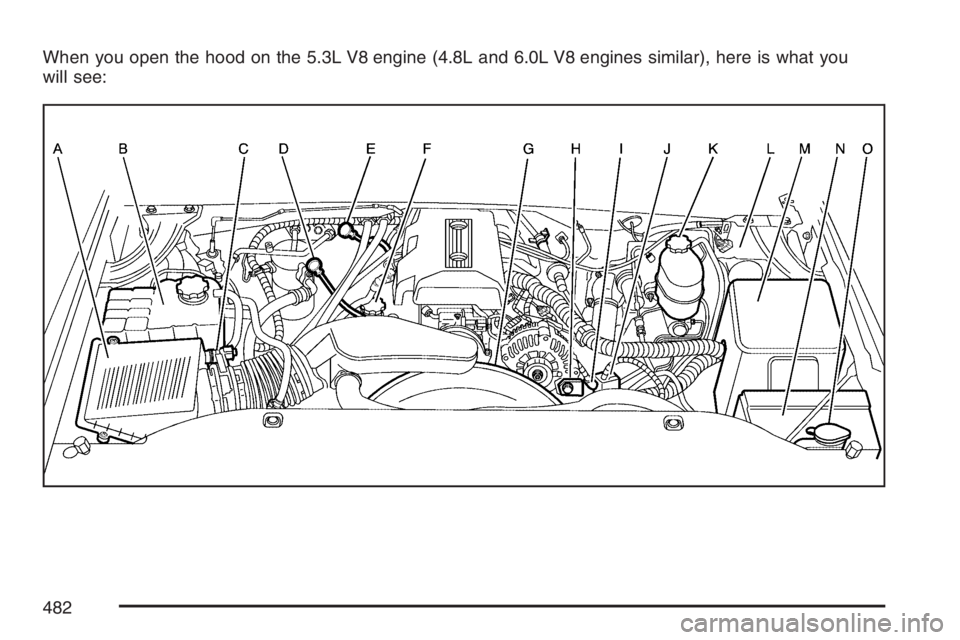
When you open the hood on the 5.3L V8 engine (4.8L and 6.0L V8 engines similar), here is what you
will see:
482
Page 484 of 674
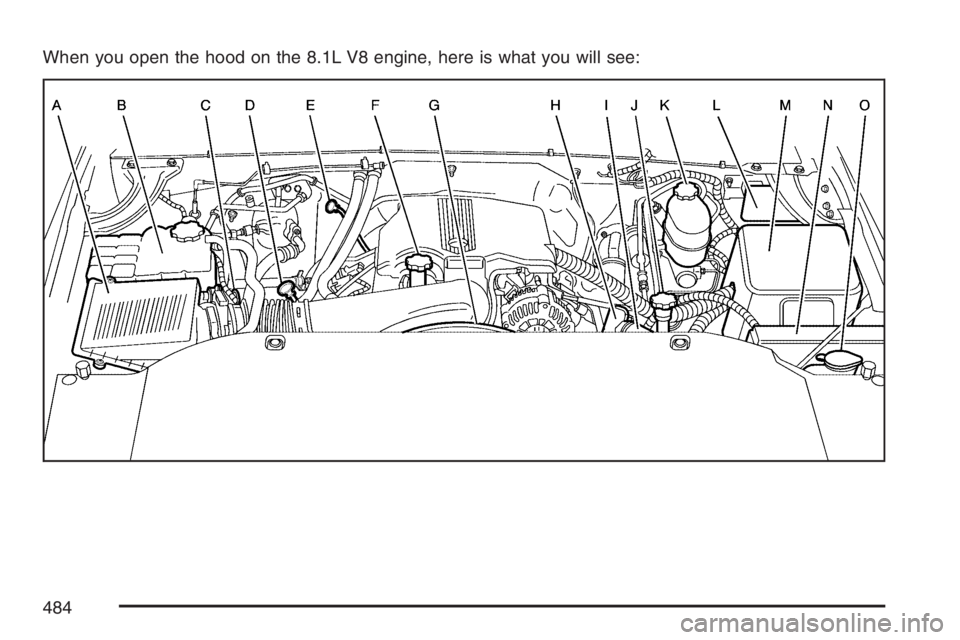
When you open the hood on the 8.1L V8 engine, here is what you will see:
484
Page 506 of 674
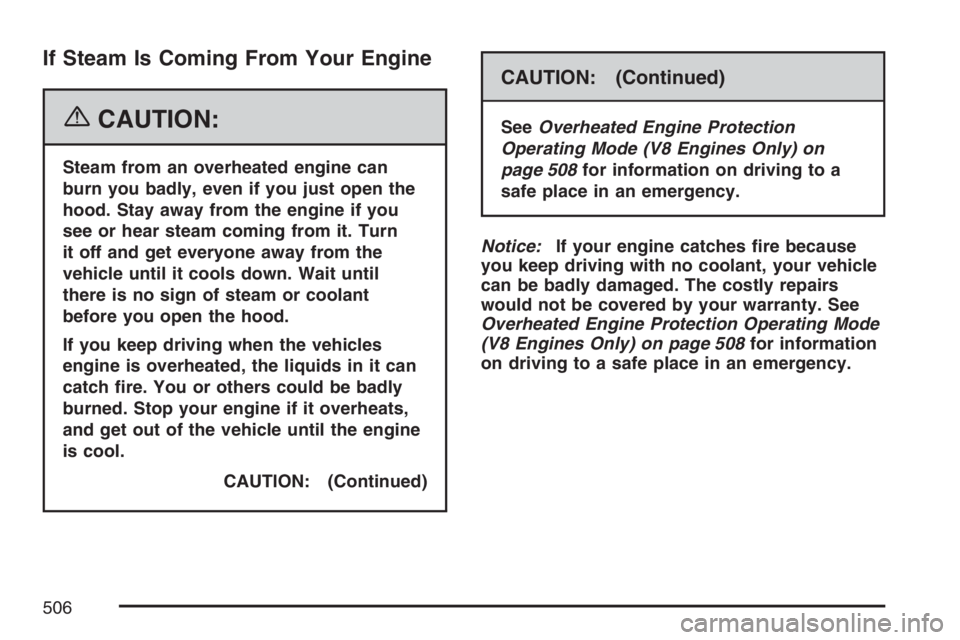
If Steam Is Coming From Your Engine
{CAUTION:
Steam from an overheated engine can
burn you badly, even if you just open the
hood. Stay away from the engine if you
see or hear steam coming from it. Turn
it off and get everyone away from the
vehicle until it cools down. Wait until
there is no sign of steam or coolant
before you open the hood.
If you keep driving when the vehicles
engine is overheated, the liquids in it can
catch �re. You or others could be badly
burned. Stop your engine if it overheats,
and get out of the vehicle until the engine
is cool.
CAUTION: (Continued)
CAUTION: (Continued)
SeeOverheated Engine Protection
Operating Mode (V8 Engines Only) on
page 508for information on driving to a
safe place in an emergency.
Notice:If your engine catches �re because
you keep driving with no coolant, your vehicle
can be badly damaged. The costly repairs
would not be covered by your warranty. See
Overheated Engine Protection Operating Mode
(V8 Engines Only) on page 508for information
on driving to a safe place in an emergency.
506
Page 507 of 674
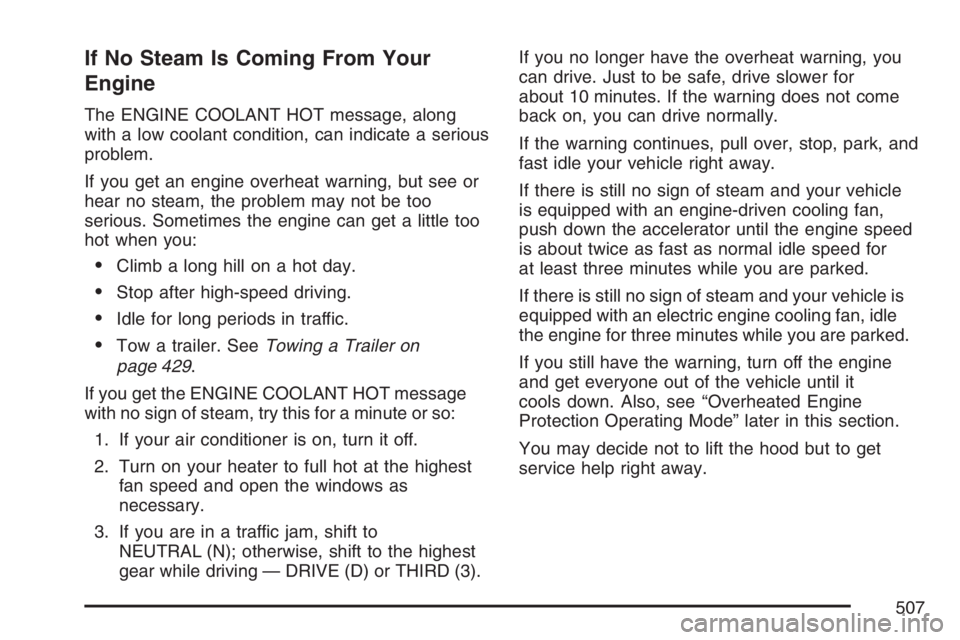
If No Steam Is Coming From Your
Engine
The ENGINE COOLANT HOT message, along
with a low coolant condition, can indicate a serious
problem.
If you get an engine overheat warning, but see or
hear no steam, the problem may not be too
serious. Sometimes the engine can get a little too
hot when you:
Climb a long hill on a hot day.
Stop after high-speed driving.
Idle for long periods in traffic.
Tow a trailer. SeeTowing a Trailer on
page 429.
If you get the ENGINE COOLANT HOT message
with no sign of steam, try this for a minute or so:
1. If your air conditioner is on, turn it off.
2. Turn on your heater to full hot at the highest
fan speed and open the windows as
necessary.
3. If you are in a traffic jam, shift to
NEUTRAL (N); otherwise, shift to the highest
gear while driving — DRIVE (D) or THIRD (3).If you no longer have the overheat warning, you
can drive. Just to be safe, drive slower for
about 10 minutes. If the warning does not come
back on, you can drive normally.
If the warning continues, pull over, stop, park, and
fast idle your vehicle right away.
If there is still no sign of steam and your vehicle
is equipped with an engine-driven cooling fan,
push down the accelerator until the engine speed
is about twice as fast as normal idle speed for
at least three minutes while you are parked.
If there is still no sign of steam and your vehicle is
equipped with an electric engine cooling fan, idle
the engine for three minutes while you are parked.
If you still have the warning, turn off the engine
and get everyone out of the vehicle until it
cools down. Also, see “Overheated Engine
Protection Operating Mode” later in this section.
You may decide not to lift the hood but to get
service help right away.
507
Page 523 of 674
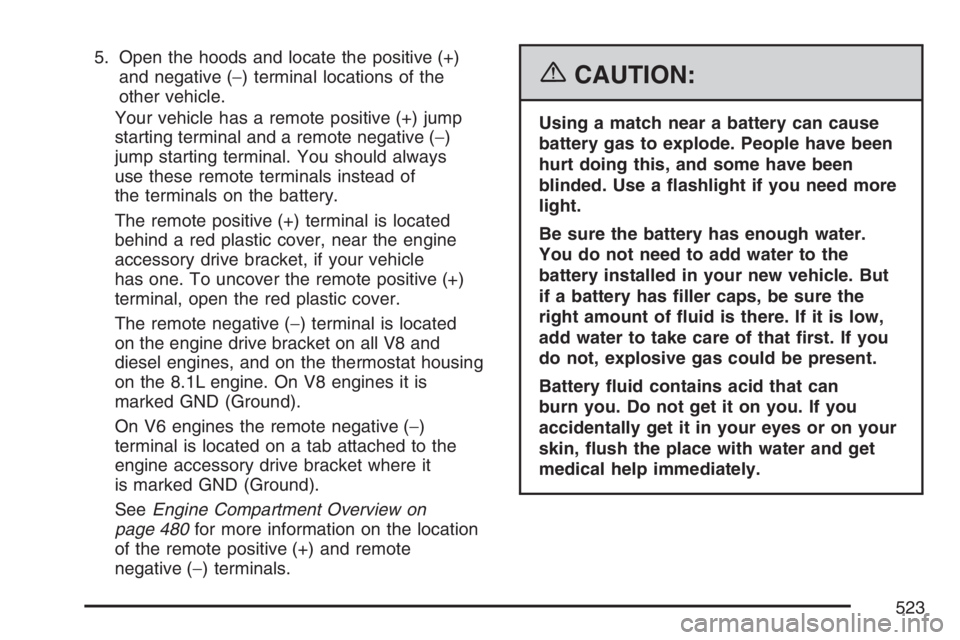
5. Open the hoods and locate the positive (+)
and negative (−) terminal locations of the
other vehicle.
Your vehicle has a remote positive (+) jump
starting terminal and a remote negative (−)
jump starting terminal. You should always
use these remote terminals instead of
the terminals on the battery.
The remote positive (+) terminal is located
behind a red plastic cover, near the engine
accessory drive bracket, if your vehicle
has one. To uncover the remote positive (+)
terminal, open the red plastic cover.
The remote negative (−) terminal is located
on the engine drive bracket on all V8 and
diesel engines, and on the thermostat housing
on the 8.1L engine. On V8 engines it is
marked GND (Ground).
On V6 engines the remote negative (−)
terminal is located on a tab attached to the
engine accessory drive bracket where it
is marked GND (Ground).
SeeEngine Compartment Overview on
page 480for more information on the location
of the remote positive (+) and remote
negative (−) terminals.
{CAUTION:
Using a match near a battery can cause
battery gas to explode. People have been
hurt doing this, and some have been
blinded. Use a �ashlight if you need more
light.
Be sure the battery has enough water.
You do not need to add water to the
battery installed in your new vehicle. But
if a battery has �ller caps, be sure the
right amount of �uid is there. If it is low,
add water to take care of that �rst. If you
do not, explosive gas could be present.
Battery �uid contains acid that can
burn you. Do not get it on you. If you
accidentally get it in your eyes or on your
skin, �ush the place with water and get
medical help immediately.
523
Page 533 of 674

Headlamps
To replace a headlamp bulb, do the following:
1. Open the hood. SeeHood Release on
page 479for more information.
2. Remove the two pins on the top of the
headlamp assembly. To remove the pins, turn
the outer pin outward and pull it straight up.
To remove the inner pin, turn it in and
pull it straight up.A. Low-Beam Headlamp
B. High-Beam Headlamp
3. Pull the headlamp assembly out.
4. Unplug the electrical connector.
5. Turn the old bulb counterclockwise and
remove it from the headlamp assembly.
6. Install the new bulb into the assembly and
turn it clockwise until it is tight.
7. Plug in the electrical connector.
8. Reinstall the headlamp assembly.
9. Reinstall and tighten the two pins.
533